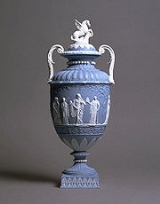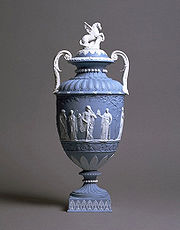
Etruria Works
Encyclopedia
The Etruria Works was a ceramics factory opened by Josiah Wedgwood
in 1769 in a district of Stoke-on-Trent
, Staffordshire
, England, which he named Etruria
. Wedgwood had previously based his business in the nearby town of Burslem
at the Ivy House Works and the Brick House Works (demolished - the Wedgwood Institute
is built on its site).
In 1767 Wedgwood paid about three thousand pounds for his new site, which was then known as the Ridgehouse Estate. It lay directly in the path of the Trent and Mersey Canal
of which Wedgwood was a promoter. On one side of the canal Wedgwood built a large house, Etruria Hall
and on the other side a factory. His architect was Joseph Pickford
.
The motto of the Etruria works was Artes Etruriae Renascuntur. This may be translated from the Latin as "The Arts of Etruria are reborn".
 Wedgwood was interested in the ancient pottery collected by Sir William Hamilton
Wedgwood was interested in the ancient pottery collected by Sir William Hamilton
in Italy. The modeller John Flaxman
was able to adapt these classical designs for the eighteenth-century market.
The products of Wedgwood's factory were greatly admired in Britain and abroad. Some of Flaxman's designs are still in production today.
Little remains of the factory today, although one surviving structure is now protected as a listed building
. The site was affected by mining subsidence, and most of the factory was demolished after the Wedgwood company moved production to Barlaston
some miles south on the Trent and Mersey Canal. Part of the site is now occupied by the local newspaper The Sentinel.
Josiah Wedgwood
Josiah Wedgwood was an English potter, founder of the Wedgwood company, credited with the industrialization of the manufacture of pottery. A prominent abolitionist, Wedgwood is remembered for his "Am I Not A Man And A Brother?" anti-slavery medallion. He was a member of the Darwin–Wedgwood family...
in 1769 in a district of Stoke-on-Trent
Stoke-on-Trent
Stoke-on-Trent , also called The Potteries is a city in Staffordshire, England, which forms a linear conurbation almost 12 miles long, with an area of . Together with the Borough of Newcastle-under-Lyme Stoke forms The Potteries Urban Area...
, Staffordshire
Staffordshire
Staffordshire is a landlocked county in the West Midlands region of England. For Eurostat purposes, the county is a NUTS 3 region and is one of four counties or unitary districts that comprise the "Shropshire and Staffordshire" NUTS 2 region. Part of the National Forest lies within its borders...
, England, which he named Etruria
Etruria, Staffordshire
Etruria is a suburb of Stoke-on-Trent, Staffordshire, England.-Home of Wedgwood:Etruria was the fourth and penultimate site for the Wedgwood pottery business. Josiah Wedgwood, who was previously based in Burslem, opened his new works in 1769. It was named after the Italian district of Etruria,...
. Wedgwood had previously based his business in the nearby town of Burslem
Burslem
The town of Burslem, known as the Mother Town, is one of the six towns that amalgamated to form the current city of Stoke-on-Trent, in the ceremonial county of Staffordshire, in the Midlands of England.-Topography:...
at the Ivy House Works and the Brick House Works (demolished - the Wedgwood Institute
Wedgwood Institute
The Wedgwood Institute is a large red-brick building that stands in Queen Street, in the town of Burslem, Stoke-on-Trent, Staffordshire, England...
is built on its site).
In 1767 Wedgwood paid about three thousand pounds for his new site, which was then known as the Ridgehouse Estate. It lay directly in the path of the Trent and Mersey Canal
Trent and Mersey Canal
The Trent and Mersey Canal is a in the East Midlands, West Midlands, and North West of England. It is a "narrow canal" for the vast majority of its length, but at the extremities—east of Burton upon Trent and west of Middlewich—it is a wide canal....
of which Wedgwood was a promoter. On one side of the canal Wedgwood built a large house, Etruria Hall
Etruria Hall
Etruria Hall in Etruria, Stoke-on-Trent, Staffordshire, England was the home of the potter Josiah Wedgwood. It was built between 1768–1771 by Joseph Pickford.Etruria Hall was the site of the innovative research into photography by Thomas Wedgwood in the 1790s...
and on the other side a factory. His architect was Joseph Pickford
Joseph Pickford
Joseph Pickford was an English architect, one of the leading provincial architects in the reign of George III.-Biography:Pickford was born in Warwickshire in 1734 but he moved as child to London when his father died. Pickford's initial training was undertaken under the stonemason and sculptor...
.
The motto of the Etruria works was Artes Etruriae Renascuntur. This may be translated from the Latin as "The Arts of Etruria are reborn".

William Hamilton (diplomat)
Sir William Hamilton KB, PC, FRS was a Scottish diplomat, antiquarian, archaeologist and vulcanologist. After a short period as a Member of Parliament, he served as British Ambassador to the Kingdom of Naples from 1764 to 1800...
in Italy. The modeller John Flaxman
John Flaxman
John Flaxman was an English sculptor and draughtsman.-Early life:He was born in York. His father was also named John, after an ancestor who, according to family tradition, had fought for Parliament at the Battle of Naseby, and afterwards settled as a carrier or farmer in Buckinghamshire...
was able to adapt these classical designs for the eighteenth-century market.
The products of Wedgwood's factory were greatly admired in Britain and abroad. Some of Flaxman's designs are still in production today.
Little remains of the factory today, although one surviving structure is now protected as a listed building
. The site was affected by mining subsidence, and most of the factory was demolished after the Wedgwood company moved production to Barlaston
Barlaston
Barlaston is a village and civil parish in the borough of Stafford in the county of Staffordshire, England. It is roughly halfway between the city of Stoke-on-Trent and the small town of Stone. According to the 2001 census the population of the parish was 2,659.-History:The old parish church of...
some miles south on the Trent and Mersey Canal. Part of the site is now occupied by the local newspaper The Sentinel.

